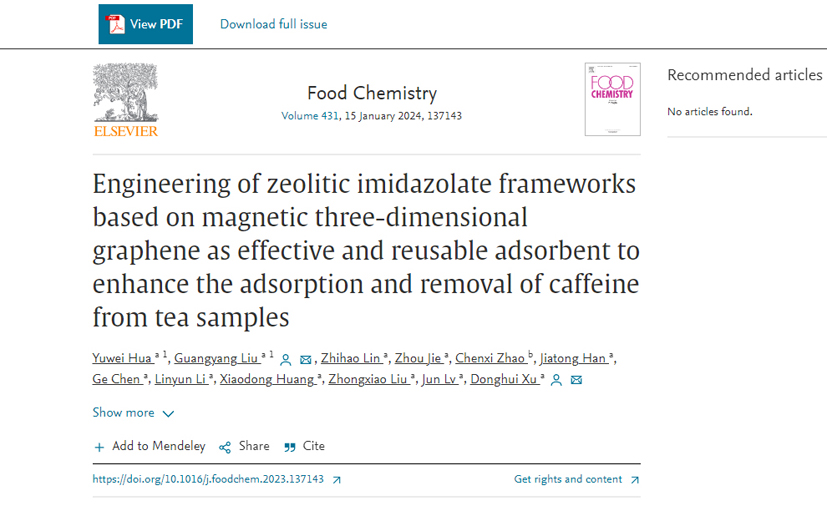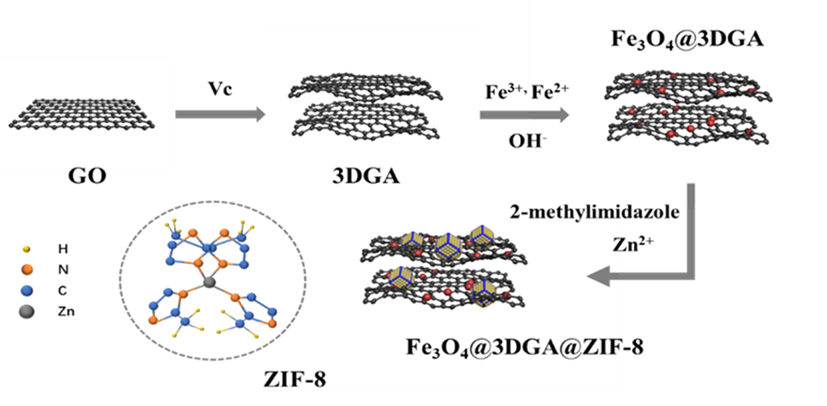
Recently, the Quality and Safety Group of the Institute of Vegetable and Flower, Chinese Academy of Agricultural Sciences (CAAS) has made new progress in the preparation of magnetic three-dimensional porous adsorbent materials and its caffeine enrichment and removal technology, and the related research results have been published in Food Chemistry under the title of "Engineering of zeolitic imidazolate frameworks based on magnetic three-dimensional graphene as effective and reusable adsorbent to enhance the adsorption and removal of caffeine from tea samples".

Fig. 1 Preparation process of Fe3O4@3DGA@ZIF-8
Caffeine, a xanthine alkaloid enriched in tea, acts as a central nervous system stimulant with the ability to reduce fatigue, improve athletic performance and mood, and boost metabolism. However, excessive intake can lead to sleep disorders, nervousness and anxiety, and elevated blood pressure, and can increase the risk of stroke and heart disease. Decaffeinated tea products are becoming increasingly popular among consumers. Traditional decaffeination technologies, such as supercritical fluid method, ionic precipitation method, water extraction method, microbial degradation method, etc., still have limitations, such as low removal efficiency, loss of active ingredients, and narrow scope of application.

Fig. 2 Caffeine adsorption properties of Fe3O4@3DGA@ZIF-8
In this study, Fe3O4@3DGA@ZIF-8 composites were successfully prepared using magnetic nanoparticles (Fe3O4) and 3DGA as nanocarriers and 3DGA flexible surface-guided directed self-assembly of ZIF-8. The results showed that Fe3O4@3DGA@ZIF-8 had a large specific surface area (162.98 m2/g), high pore volume (0.35 cm3/g), super paramagnetism (40.8 emu/g), high caffeine removal (>99%) and good reusability. The maximum adsorption of caffeine on the composite was found to be 19.57 mg/g under the optimal experimental conditions. The adsorption and mass transfer processes of caffeine on the composite were investigated in depth by using static and dynamic adsorption modeling calculations, which revealed that the static adsorption conformed to the Langmuir model, which is mainly dominated by the single-molecule adsorption, and that the kinetic fitting conformed to the pseudo second-order model, which is mainly dominated by the chemical adsorption to control the adsorption process. Finally, the composite was successfully used for the adsorption removal of caffeine from green tea, oolong tea, black tea, white tea and other tea broth samples. This study solved the problems of low enrichment efficiency of caffeine in tea samples and the adsorbent is not easy to be recovered, and provided a new research path for the design and preparation of novel three-dimensional porous adsorbent materials, and provided a new idea for the controlled removal of caffeine from tea.
The Institute of Vegetable and Flower Research, Chinese Academy of Agricultural Sciences (CAAS), was the first author of the paper, and Master's degree student of the Institute of Vegetable and Flower Research, Ms. Yuwei Hua and Researcher Guangyang Liu, were the co-first authors, while Researcher Guangyang Liu and Researcher Donghui Xu were the corresponding authors. This research was funded by the National Key Research and Development Program, the National Bulk Vegetable Industry Technology System, the Agricultural Science and Technology Innovation Project of the Chinese Academy of Agricultural Sciences, and supported by the National Key Laboratory of Vegetable Biological Breeding and the Key Laboratory of Vegetable Quality and Safety Control of the Ministry of Agriculture and Rural Development.
Link to the paper:https://www.sciencedirect.com/science/article/abs/pii/S0308814623017612